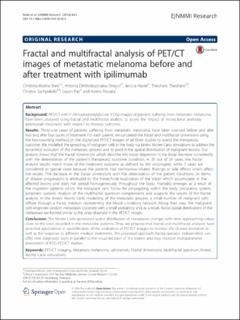| dc.contributor.author | Breki, Christina-Marina | |
| dc.contributor.author | Dimitrakopoulou-Strauss, Antonia | |
| dc.contributor.author | Hassel, Jessica | |
| dc.contributor.author | Theoharis, Theoharis | |
| dc.contributor.author | Sachpekidis, Christos | |
| dc.contributor.author | Pan, Leyun | |
| dc.contributor.author | Provata, Astero | |
| dc.date.accessioned | 2020-04-27T08:28:47Z | |
| dc.date.available | 2020-04-27T08:28:47Z | |
| dc.date.created | 2016-12-07T13:22:23Z | |
| dc.date.issued | 2016 | |
| dc.identifier.citation | EJNMMI Research. 2016, 6 (61) | en_US |
| dc.identifier.issn | 2191-219X | |
| dc.identifier.uri | https://hdl.handle.net/11250/2652554 | |
| dc.description.abstract | Background
PET/CT with F-18-fluorodeoxyglucose (FDG) images of patients suffering from metastatic melanoma have been analysed using fractal and multifractal analysis to assess the impact of monoclonal antibody ipilimumab treatment with respect to therapy outcome.
Results
Thirty-one cases of patients suffering from metastatic melanoma have been scanned before and after two and after four cycles of treatment. For each patient, we calculated the fractal and multifractal dimensions using the box-counting method on the digitalised PET/CT images of all three studies to assess the therapeutic outcome. We modelled the spreading of malignant cells in the body via kinetic Monte Carlo simulations to address the dynamical evolution of the metastatic process and to predict the spatial distribution of malignant lesions. Our analysis shows that the fractal dimensions which describe the tracer dispersion in the body decrease consistently with the deterioration of the patient’s therapeutic outcome condition. In 20 out of 24 cases, the fractal analysis results match those of the treatment outcome as defined by the oncologists, while 7 cases are considered as special cases because the patients had non-tumour-related findings or side effects which affect the results. The decrease in the fractal dimensions with the deterioration of the patient conditions (in terms of disease progression) is attributed to the hierarchical localisation of the tracer which accumulates in the affected lesions and does not spread homogeneously throughout the body. Fractality emerges as a result of the migration patterns which the malignant cells follow for propagating within the body (circulatory system, lymphatic system). Analysis of the multifractal spectrum complements and supports the results of the fractal analysis. In the kinetic Monte Carlo modelling of the metastatic process, a small number of malignant cells diffuse through a fractal medium representing the blood circulatory network. Along their way, the malignant cells engender random metastases (colonies) with a small probability and, as a result, fractal spatial distributions of the metastases are formed similar to the ones observed in the PET/CT images.
Conclusions
The Monte Carlo-generated spatial distribution of metastases changes with time approaching values close to the ones recorded in the metastatic patients. Thus, we propose that fractal and multifractal analyses have potential applications in quantification of the evaluation of PET/CT images to monitor the disease evolution as well as the response to different medical treatments. The proposed approach, being operator independent, can offer new diagnostic tools in parallel to the visual location of the lesions and may improve multiparameter assessment of FDG PET/CT studies. | en_US |
| dc.language.iso | eng | en_US |
| dc.publisher | Springer Verlag | en_US |
| dc.rights | Navngivelse 4.0 Internasjonal | * |
| dc.rights.uri | http://creativecommons.org/licenses/by/4.0/deed.no | * |
| dc.title | Fractal and multifractal analysis of PET/CT images of metastatic melanoma before and after treatment with ipilimumab | en_US |
| dc.type | Peer reviewed | en_US |
| dc.type | Journal article | en_US |
| dc.description.version | publishedVersion | en_US |
| dc.source.volume | 6 | en_US |
| dc.source.journal | EJNMMI Research | en_US |
| dc.source.issue | 61 | en_US |
| dc.identifier.doi | 10.1186/s13550-016-0216-5 | |
| dc.identifier.cristin | 1409562 | |
| dc.description.localcode | Open Access This article is distributed under the terms of the Creative Commons Attribution 4.0 International License (http://creativecommons.org/licenses/by/4.0/), which permits unrestricted use, distribution, and reproduction in any medium, provided you give appropriate credit to the original author(s) and the source, provide a link to the Creative Commons license, and indicate if changes were made. | en_US |
| cristin.ispublished | true | |
| cristin.fulltext | original | |
| cristin.qualitycode | 1 | |

